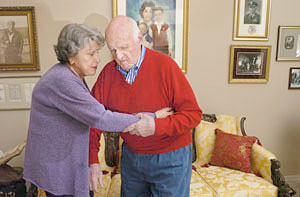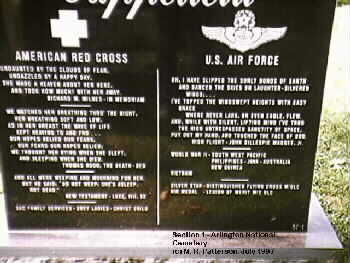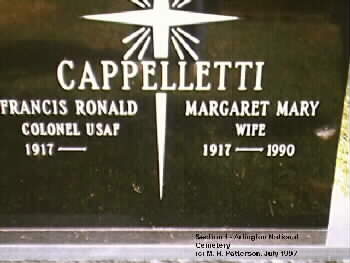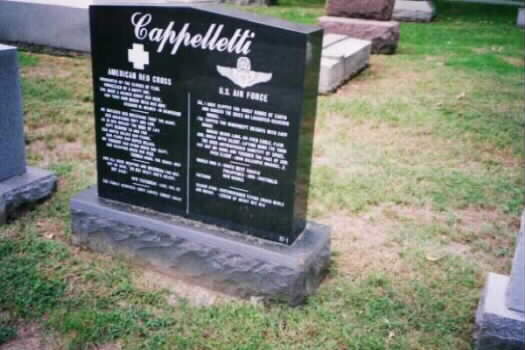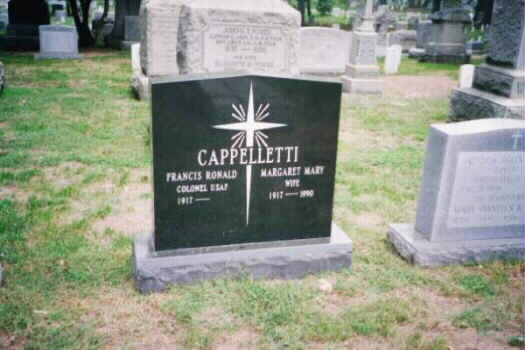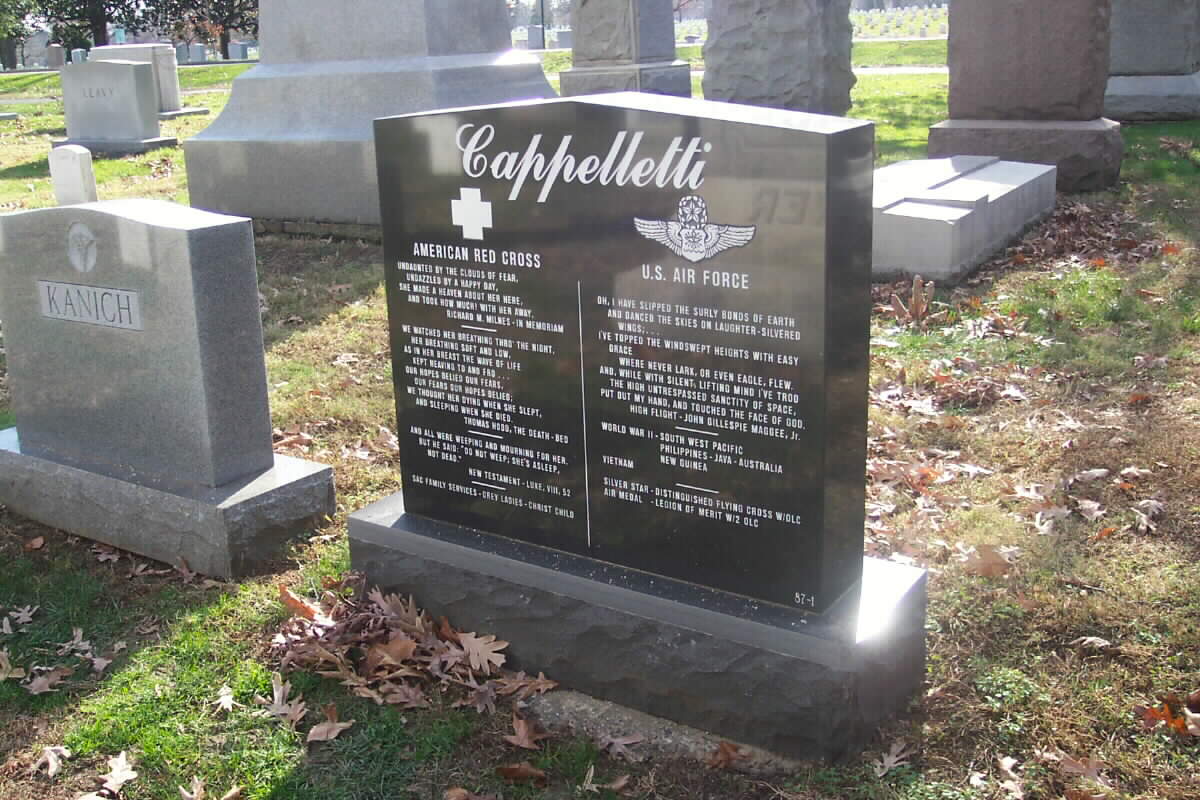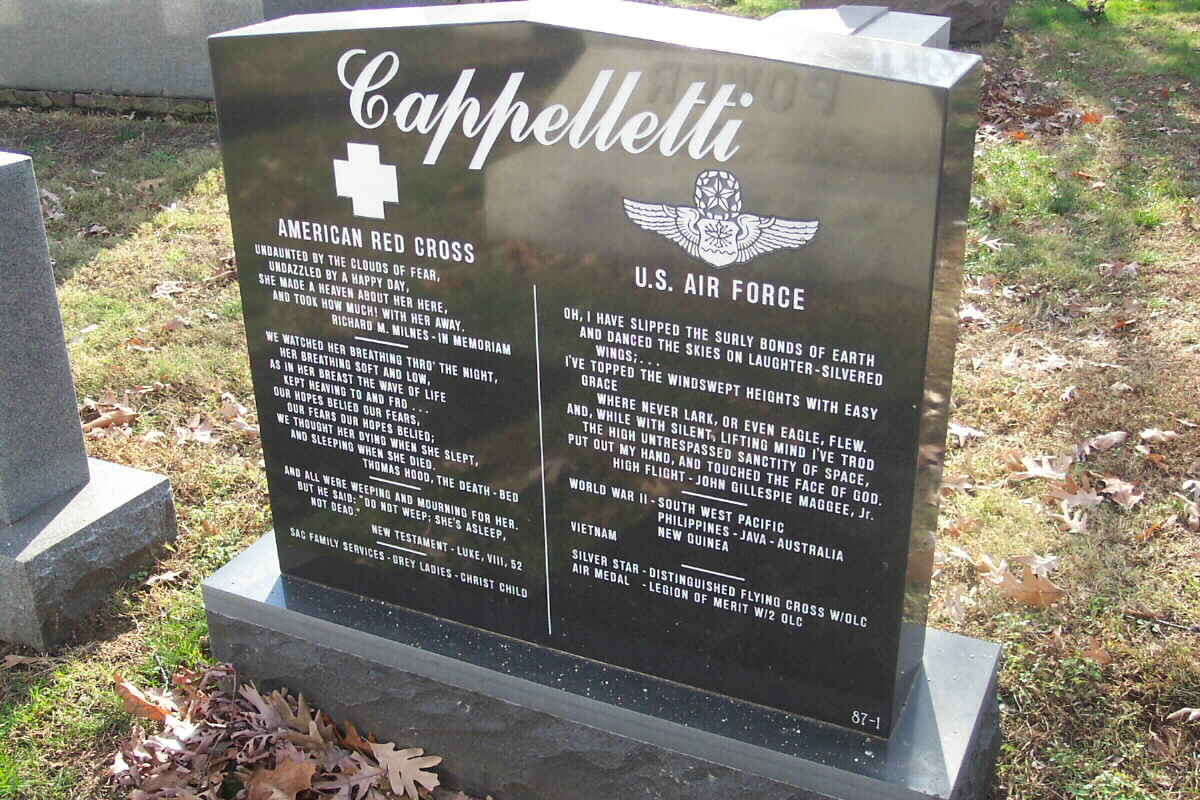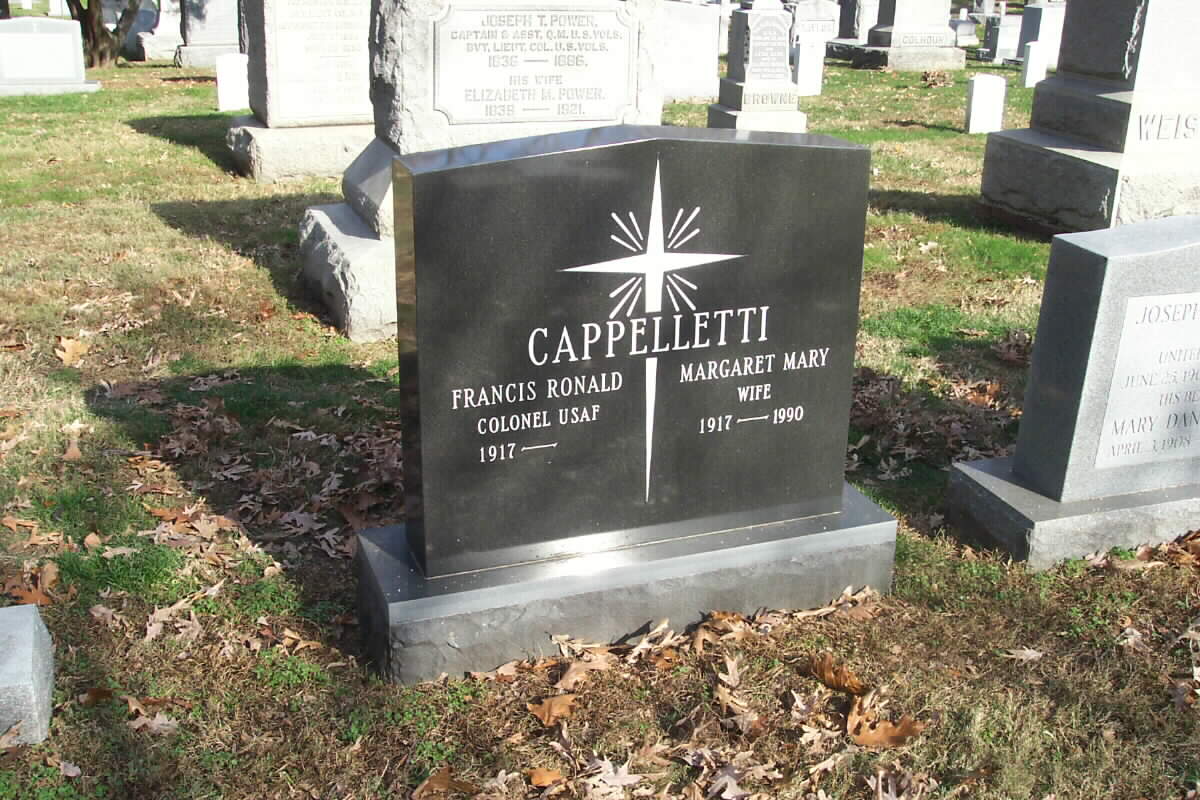While Colonel Cappelletti remains living at this time (the Colonel passed away on 28 February 2007, see below for details), his future stone and that of his wife (see below) is, in my opinion, one of the most beautiful in the entire cemetery. His side of the stone reads:
“WWII, Southwest Pacific, Philippines, Java, Australia, New Guinea, Vietnam. Silver Star, Distinguished Flying Cross with Oak Leaf Cluster, Air Medal, Legion of Merit with Oak Leaf Cluster. Born in 1917.”
In the twilight of the colonel
As the health of a retired Air Force colonel declines, his wife steps in to be his voice.
December 8, 2005
Rose Cappelletti helps her husband, Francis Cappelletti, 88, who has Alzheimer’s disease.
He served as a navigator on a B-17 during World War II.
SAFETY HARBOR, FLORIDA – The 62-year-old divorcee needed another man like she needed tuberculosis.
But at a friend’s urging, she agreed to meet Francis Cappelletti, a retired Air Force Colonel who served in World War II and the Vietnam War.
Both spoke the same languages: Italian, Russian, French. Their fathers were born in Italy, just 10 miles apart.
They married. Rose Cappelletti likes to say it was like putting on comfortable slippers after wearing tight shoes for years.
Frank regaled her with stories about his first love, the B-17 Flying Fortress that always brought him home safely. Rose laid out his flight suit and medals in their living room, creating an altar to her hero.
Six years ago, Alzheimer’s disease started to steal his memories. But before he closes his eyes for good, Rose wants to remember the man her husband used to be.
“It’s a shadow of a man but he’s still there,” said Rose, 76. “He can’t speak for himself but I’ll be his voice.”
Francis R. Cappelletti. Born August 16, 1917. Navigator on one of the B-17s that survived the December 8, 1941, bombing of Clark Field in the Philippines. Flew 91 missions against the Japanese. Participated in the Bikini Atom Bomb tests. Pioneered flight to the North Pole.
“I salute you, Colonel,” she tells him.
He laughs.
“You wanted the airplane to bring you home. Every time, it did,” he said. “It was wonderful to have it bring you home, you know? It was wonderful.”
As he reminisces about the Flying Fortress, his face crumples.
“That’s a love affair,” he said. “You always stayed with it. It stayed with you.”
Now it’s up to Rose to fill the gaps in his memory. How he watched as other B-17s vanished from the sky.
How that was when he knew the 19th Bombardment Group had lost more men.
Frank often says no one cares about his long-ago accomplishments.
That’s not true, she tells him.
One day, he’ll forget who she is. But before that long goodbye, she wants to remember him in life.
Francis Cappelletti, 89; World War II Air Veteran
Saturday, March 10, 2007
Francis R. Cappelletti, 89, an Air Force Colonel who later worked as a civilian for the Department of the Navy, died of complications from Alzheimer’s disease February 28, 2007, at his home in Safety Harbor, Florida.
Colonel Cappelletti, who joined the Army Air Corps in 1940, was serving as officer of the day at Clark Field in the Philippines in 1941 when the Japanese bombed it, the day after the attack on Pearl Harbor. He flew 91 combat missions as a navigator in the South Pacific during World War II and received the Silver Star, the Distinguished Flying Cross and the Air Medal for his wartime service.
After the war, Colonel Cappelletti participated in the atomic bomb tests “Able” and “Baker” as part of Operation Crossroads on Bikini Island in July 1949. That was followed by service in counterintelligence in Germany as part of the Office of Special Investigations.
He worked at Offutt Air Force Base in Omaha during the 1950s while the Strategic Air Command was established, and he specialized in applying new computer technologies to enemy target planning. In 1965, he began a year’s service in Vietnam, followed by a posting to the Pentagon, where he was chief of special activities for the Defense Intelligence Agency. He retired as a full Colonel in 1970.
Among his military awards were three awards of the Legion of Merit. He spoke five languages, using this skill to give military briefings to visiting foreign officers.
He then worked at Computer Sciences Corporation and for the Department of the Navy as a civilian, retiring in 1981. He volunteered at the Smithsonian’s Air and Space Museum for a number of years, where he translated newly found documents from Russian immigrants into English. His interests included astronomy, physics and history, especially of the Italian Renaissance. He lived in Annandale, Virginia, from 1966 to 1992.
He was born in Koppel, Pennsylvania, to Italian immigrants and grew up in Barre, Vermont. He graduated from St. Alexander College and received a master’s degree in 1939 from Laval University in Quebec.
His first wife, Margaret Cappelletti, died in 1990. After marrying again in 1992, he moved to Florida.
Survivors include his wife of 14 years, Rose Cappelletti of Safety Harbor; a daughter from his first marriage, Martha Sewell of Falls Church; three stepsons, Enea John Vanzo of Bainbridge, Georgia, Leonard Freed of Clarksville, Tennessee, and Dr. Fred Freed of St. Petersburg Beach, Florida; two sisters; and a brother.
Cappelletti, Francis R. “Frank,” 89, of Safety Harbor, formerly of St. Pete Beach, died Wednesday (February 28, 2007) at home under the care of his wife, Rose, and Hospice of the Florida Suncoast.
He was born in Koppel, Pennsylvania, and moved to St. Pete Beach in 1992 from Annandale, Virginia. In 1998, he moved from St. Pete Beach to Safety Harbor.
He graduated from Laval University, Quebec City, and entered the Army Air Forces in 1940. He completed navigation training with Pan American Airways, Coral Gables, in 1941 and was assigned to the 19th Bomb Group, a B-17 outfit.
He was at Clark Field in the Philippines when the Japanese attacked on December 8, 1941, and he flew 91 missions against the Japanese throughout the Far East Theater of Operations.
He pioneered the North Pole flight from Alaska to the North Pole and back to Fairbanks, Alaska, before civil aviation used the polar route from the United States to Europe. He later was assigned to Strategic Air Command Headquarters under General Curtis LeMay. He participated in the Cuban Missile Crisis operation and also served in the Vietnam War.
His awards and medals included the Distinguished Flying Cross with cluster, Silver Star with clusters and Air Medal.
He retired as an Air Force colonel after 30 years service and then worked 11 years for the Defense Department and civil service. He worked three years as a volunteer for the Smithsonian Institution, translating documents from Russian into English.
He was a member of St. John’s Catholic Church in St. Pete Beach, the Military Officers Association of America, Boys & Girls Club and Kiwanis. In addition to his wife of 15 years, survivors include a daughter, Martha Sewell, Falls Church, Virginia; three stepsons, Dr. John Vanzo, Bainbridge, Georgia, Leonard Freed, Clarksville, Tennessee, and Dr. Frederick Freed, St. Pete Beach; a brother, Joseph, Maine; two sisters, Assunta Langevin, Vermont, and Sister Dora Cappelletti of the Passionist Order, Hereford, England; and three grandchildren, Francesca, David and Sofia Marie Freed.
Michael Robert Patterson was born in Arlington and is the son of a former officer of the US Army. So it was no wonder that sooner or later his interests drew him to American history and especially to American military history. Many of his articles can be found on renowned portals like the New York Times, Washingtonpost or Wikipedia.
Reviewed by: Michael Howard

